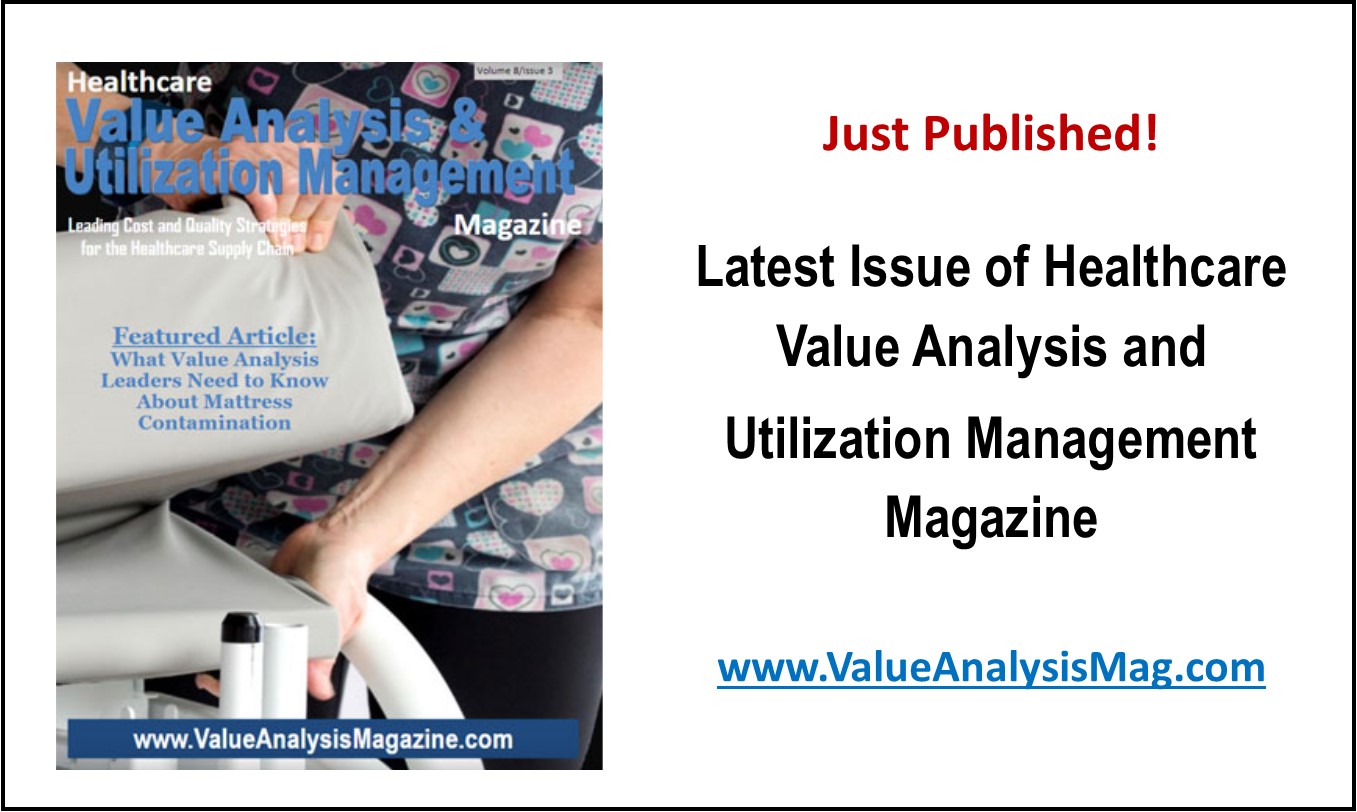James Russell, RN-BC, Value Analysis Facilitator, UF Health at Jacksonville
“What’s your value analysis onboarding process?” During an interview for a Value Analysis Facilitator (VAF), we had a candidate ask this question. We looked at each other and thought, “Well, we show you where your office is, give you a code to get into the computer, and off you go!” Of course, that’s not what we said. It was, however, an excellent and appropriate question.
Value analysis is a relatively young profession, when compared to nursing, medicine, materials management, sterile processing, and central supply (all departments that value analysis interacts with routinely). Most VAF’s (but not all) I know are nurses, so I’ll analogize this to nursing. In the 1980’s, when I was a new nurse (probably before some of you were born), my orientation consisted of a 12-week critical care course and then 12 more weeks of working alongside clinically expert preceptors who tried to keep me from killing my patients. I’m being facetious. Sort of. The point is, I went through numerous procedures to ensure I was ready to do my job before I was ever “on my own,” including competency checklists, actual exams (both written and hands-on), and return demonstrations of the management of complicated equipment such as intra-aortic balloon pumps (IABP’s), mechanical ventilators, and cardiac defibrillators. In my value analysis orientation, 20 years later, I was shown my office and told, “Good luck! Now go save us some money!” Not really, but not all that far off, either.
The point here is that reliance upon an individual hospital to orient a new VAF can be sketchy at best. There may be thousands of nurses in the hospital and a well thought out orientation process…but there may only be one or two VAF’s in that same hospital. Who orients them? Luckily, there are some resources available to help.
When I began my official value analysis role in 2008 (I had been doing it unofficially since 2005), I was lucky enough to be part of an academic medical center that was a member of the University HealthSystem Consortium (UHC), which had a formal value analysis orientation. This consisted of a full week of training with other new VAF’s at their Chicago offices. A large portion of the curriculum was geared toward project management and how to run a meeting. The information was quite helpful. What was even more helpful was the connections I was able to make with the folks doing my job in other facilities (they had the forethought to include experienced VAF’s as guest instructors). Again, with a “normal” nursing job, you are not the only critical care nurse in the hospital and you have someone to help you clarify what CVVHDF is. VAF’s usually don’t actually have many peers in their own facilities. Having a manager or director at the same level doesn’t make them a peer. Having access to a network of colleagues that I could bounce ideas off of and run “stupid” questions by was invaluable. At the time, I had a boss who’d often say, “There are no stupid questions, just stupid people who ask questions.” That certainly kept me from asking him what PPI meant the first time I heard it!
But I could call Barbara in Charlottesville, Joan in Birmingham, Jen in Chicago, Kathy in Ann Arbor, John in Los Angeles, Kamy in Denver, or Dorcas in Portland and say, “What in the world is PPI?” They’d patiently guide me through physician preference items, without bringing up that I’d asked the same thing two months ago. Again, access to this kind of network was invaluable. Luckily, we all have access to the Association of Healthcare Value Analysis Professionals (AHVAP) which has a wonderful blog on their website. It’s a great place to ask questions and share knowledge. Another source for new VAF’s is this magazine you’re reading right now! While there are some great articles in other magazines, such as Healthcare Purchasing News or Nursing Management, they are not completely devoted to value analysis. This one is.
Additionally, I found out about the power of attending conferences. As a Nurse Manager and Nursing Director, I had attended many national conferences before and thought of them as basically an excuse to travel somewhere. NTI is in Vegas? I’m there! But value analysis conferences are different. I’ve learned some really important lessons there. If I can steal a quote from someone I can’t remember, “If intelligence is not repeating your mistakes, then wisdom might be not repeating the mistakes of others.” Here’s a great example of getting an idea from a colleague and running with it. I learned from Cindy, at a national conference, that there was interesting clinical evidence regarding the effectiveness of thigh-high vs. knee-high sequential compression devices (SCD’s). When I got home, I did the research, noted the tiny P-values that were statistically insignificant, converted almost all of my hospital’s “thighs” to “knees,” and saved my hospital nearly 6 figures by altering our utilization of products we already bought. A year later, doing our follow up with clinical (and not just financial) data, we discovered our DVT/PE rates (blood clots) had actually gone down (possibly from increased patient compliance with the more comfortable size).
This is the very embodiment of a value analysis “win-win”. An improvement in patient outcomes and a decrease in direct supply costs. We didn’t even experience a change in our products (the pain of conversion) or pricing (the pain of negotiating). When bragging about this project to another peer, Todd from LA County, he said, “Well done, you’ve graduated from Value Analysis 101. Way to go.” I was initially kind of offended at this, but soon realized that he was right. I was still new and there was a lot more to learn. For example, the term utilization is a value analysis buzz word (it’s even in the title of this magazine!), but what does it actually mean? Here’s another real-world example that may help explain it to new folks.
Suppose your hospital pays $8.00 for a disposable pulse oximetry (POx) sensor (Sp02) and you buy 100,000 of them annually. Do the math and you end up with a significant annual spend of $800,000. When negotiating prices, there’s only so far you can go. Perhaps you can threaten to move to a competitor and even perform a clinical evaluation (of what amounts to Coke vs. Pepsi, based on the evidence). Suppose you’re able to negotiate a savings of $0.25 per POx sensor. That’s 100,000 quarters. $25,000 in annual cost savings. Well done! Here’s a different project with the same product…
Suppose your hospital performs 15,000 surgeries annually. In pre-op, you place a pulse oximetry (POx) sensor on every patient’s right hand, because the vital signs monitor is on that side. When the patient rolls into the OR, you place a POx sensor on every patient’s left hand, because the anesthesia machine is on that side. Every patient that rolls into PACU (the Recovery Room) has two POx sensors, one on each side. The nurses in PACU are the ones who alerted you to this!
We have found that by moving the pre-op machines to the other side of the bed, you’ve saved $8.00, 15,000 times. $120,000 in utilization savings! Wasn’t that more fun? Utilization analysis is like detective work. Sure, negotiating can be fun too, but there are probably folks in your organization that are better at it than you (Purchasing, for one). Nobody does product utilization but you. This can be your wheelhouse. You are the translator. You can explain continuous veno-venous hemo-diafiltration and IABP’s to the operational folks in Purchasing, Contracting, and Finance. You can also explain what SKUs, POs, and FMV is to your clinical folks. You’re the perfect liaison! I dislike that word (not sure why), but it’s accurate.
Here’s the point…use your connections. I went to a conference, got an idea, and saved my hospital >$90,000. That’s enough to send me to a lot more conferences! Value analysis conferences are much more interactive than the average and you might actually learn some nuggets of wisdom that you can take back with you. My friend Neil from Richmond went to a conference and came back repeating the same phrase over and over, regarding challenging the status quo: “Culture eats strategy for breakfast.” I don’t remember the source of the quote, but how apropos to value analysis? I call it kicking anthills and watching people get hysterical and say the sky is falling, but that’s probably offensive to someone.
Having access to an email listserv, or a blog on a website, or an article in a magazine, or a conference, or a WebEx, can provide priceless insight into this fascinating world we call value analysis. You really don’t have to re-create the wheel.
Jim Russell is a Value Analysis Facilitator UF Health at Jacksonville and has more than 25 years of nursing experience, specializing in critical care and psychiatry. He has been a Staff Nurse, Charge Nurse, Clinical Coordinator, Nurse Manager, Director, and Chief Nursing Officer. He worked for many years in the for-profit community healthcare sector and also has several Academic Medical Centers on his resume. Jim sat for 5 years on the Nursing Advisory Board for a HealthTrust, performing Value Analysis for nursing related products and represented more than 70 hospitals. He is currently on several Advisory Councils and Special Interest Groups for UHC and Novation. When not at work, he can be found rolling around with his hyperactive rescue Husky. You can contact Russell with your questions or comments at James.Russell@jax.ufl.edu.




